Quality Management in Healthcare: Case Study and Analysis
VerifiedAdded on 2023/06/11
|24
|8157
|419
Report
AI Summary
This report analyzes quality and safety issues within a healthcare setting, prompted by patient complaints regarding medical errors and poor management. It identifies specific quality and safety concerns, including medication errors, unclear documentation, poor communication, and inadequate patient care. The report delves into the causes and contributing factors of these issues, such as understaffing, lack of empathy, poor handover practices, and inadequate training. It also examines the frequency of these occurrences and proposes preventative actions, including staff training, improved communication, and adherence to ethical standards. Furthermore, the report analyzes the hospital's safety culture using the Manchester Patient Safety Framework, evaluating its maturity and highlighting areas for improvement. Finally, it outlines the actions the CEO should take to address the identified issues, emphasizing the importance of resource allocation, improved communication, teamwork, and a commitment to quality patient care, including a plan using the Plan-Do-Check-Act cycle to address medication management issues. The report aims to provide a comprehensive understanding of the problems and offer practical solutions to enhance patient safety and quality of care.
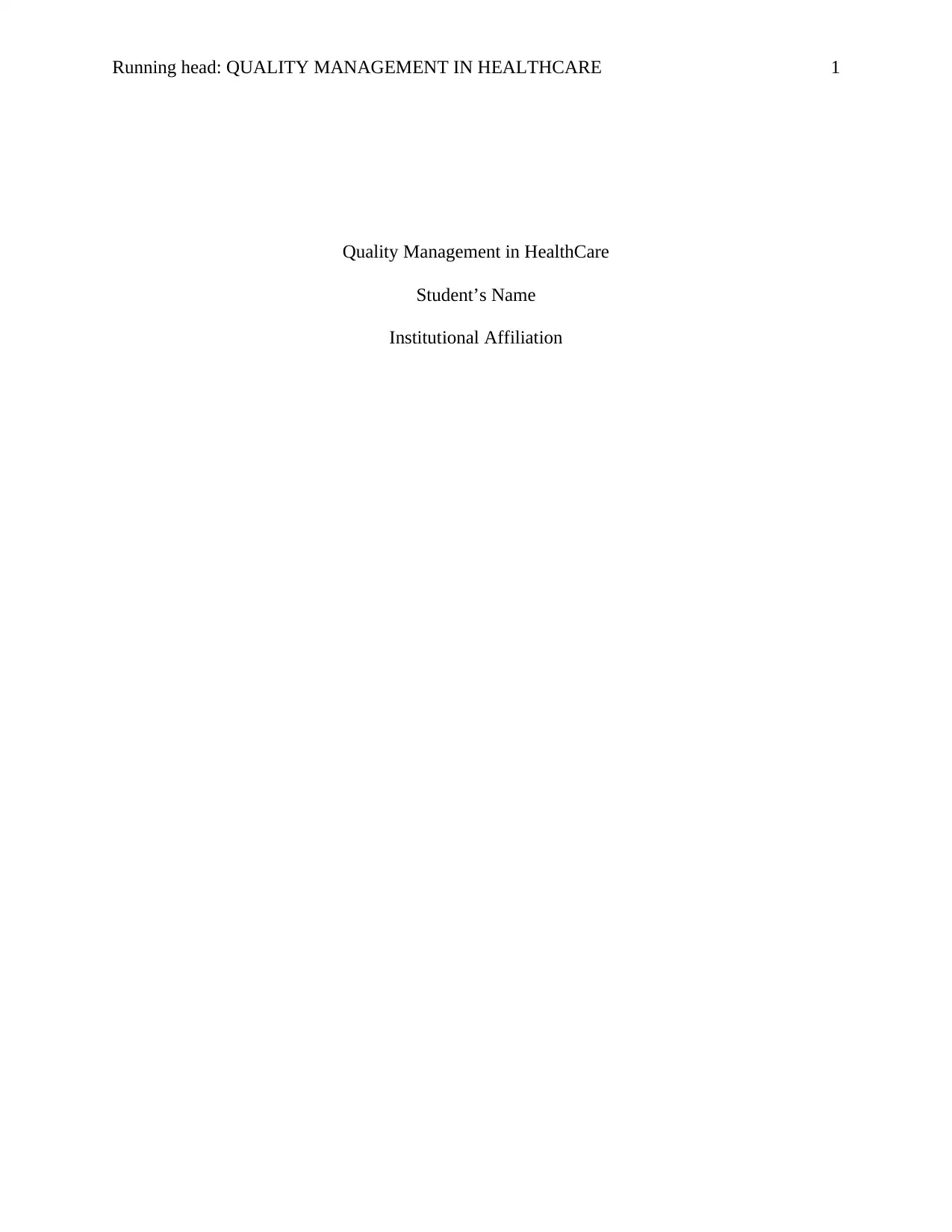
Running head: QUALITY MANAGEMENT IN HEALTHCARE 1
Quality Management in HealthCare
Student’s Name
Institutional Affiliation
Quality Management in HealthCare
Student’s Name
Institutional Affiliation
Paraphrase This Document
Need a fresh take? Get an instant paraphrase of this document with our AI Paraphraser
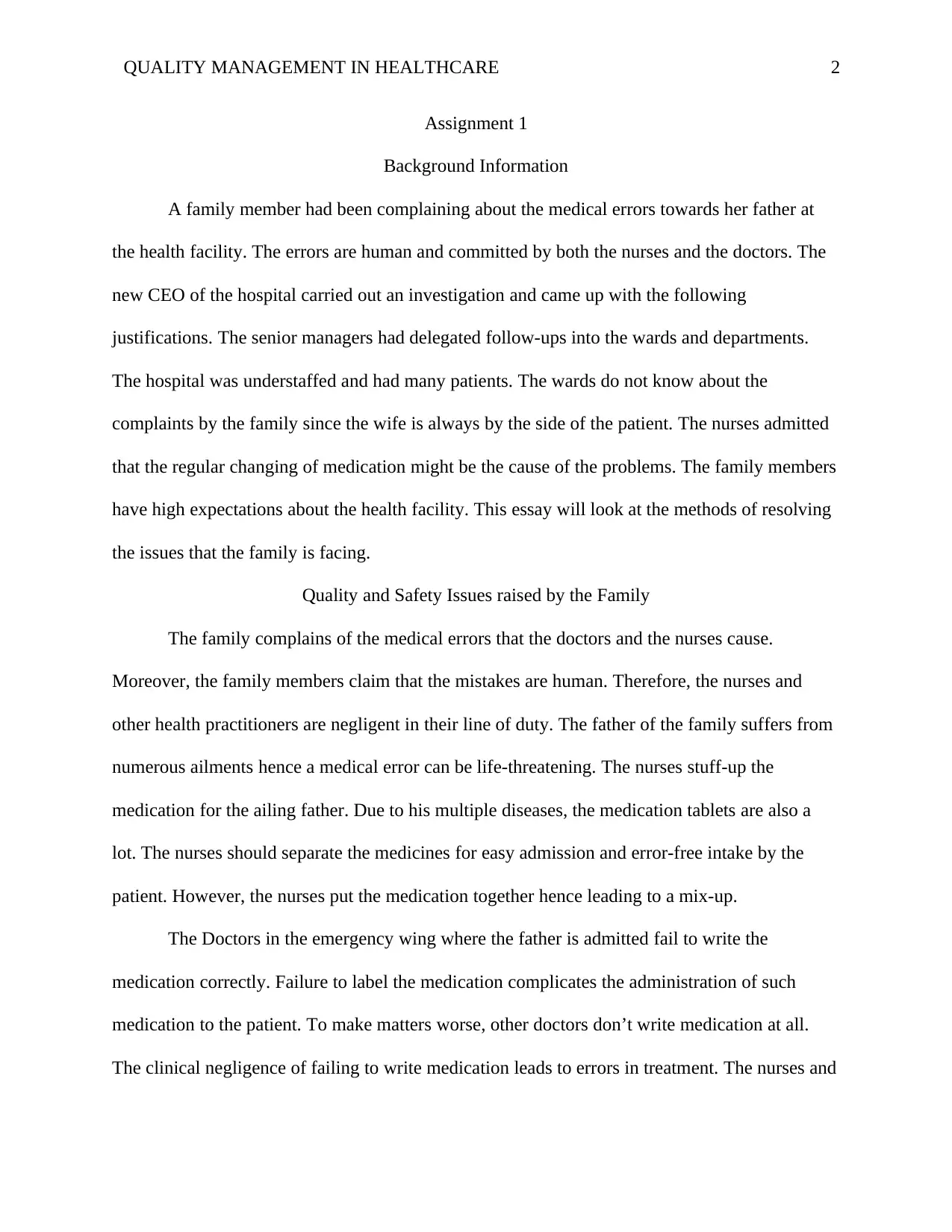
QUALITY MANAGEMENT IN HEALTHCARE 2
Assignment 1
Background Information
A family member had been complaining about the medical errors towards her father at
the health facility. The errors are human and committed by both the nurses and the doctors. The
new CEO of the hospital carried out an investigation and came up with the following
justifications. The senior managers had delegated follow-ups into the wards and departments.
The hospital was understaffed and had many patients. The wards do not know about the
complaints by the family since the wife is always by the side of the patient. The nurses admitted
that the regular changing of medication might be the cause of the problems. The family members
have high expectations about the health facility. This essay will look at the methods of resolving
the issues that the family is facing.
Quality and Safety Issues raised by the Family
The family complains of the medical errors that the doctors and the nurses cause.
Moreover, the family members claim that the mistakes are human. Therefore, the nurses and
other health practitioners are negligent in their line of duty. The father of the family suffers from
numerous ailments hence a medical error can be life-threatening. The nurses stuff-up the
medication for the ailing father. Due to his multiple diseases, the medication tablets are also a
lot. The nurses should separate the medicines for easy admission and error-free intake by the
patient. However, the nurses put the medication together hence leading to a mix-up.
The Doctors in the emergency wing where the father is admitted fail to write the
medication correctly. Failure to label the medication complicates the administration of such
medication to the patient. To make matters worse, other doctors don’t write medication at all.
The clinical negligence of failing to write medication leads to errors in treatment. The nurses and
Assignment 1
Background Information
A family member had been complaining about the medical errors towards her father at
the health facility. The errors are human and committed by both the nurses and the doctors. The
new CEO of the hospital carried out an investigation and came up with the following
justifications. The senior managers had delegated follow-ups into the wards and departments.
The hospital was understaffed and had many patients. The wards do not know about the
complaints by the family since the wife is always by the side of the patient. The nurses admitted
that the regular changing of medication might be the cause of the problems. The family members
have high expectations about the health facility. This essay will look at the methods of resolving
the issues that the family is facing.
Quality and Safety Issues raised by the Family
The family complains of the medical errors that the doctors and the nurses cause.
Moreover, the family members claim that the mistakes are human. Therefore, the nurses and
other health practitioners are negligent in their line of duty. The father of the family suffers from
numerous ailments hence a medical error can be life-threatening. The nurses stuff-up the
medication for the ailing father. Due to his multiple diseases, the medication tablets are also a
lot. The nurses should separate the medicines for easy admission and error-free intake by the
patient. However, the nurses put the medication together hence leading to a mix-up.
The Doctors in the emergency wing where the father is admitted fail to write the
medication correctly. Failure to label the medication complicates the administration of such
medication to the patient. To make matters worse, other doctors don’t write medication at all.
The clinical negligence of failing to write medication leads to errors in treatment. The nurses and
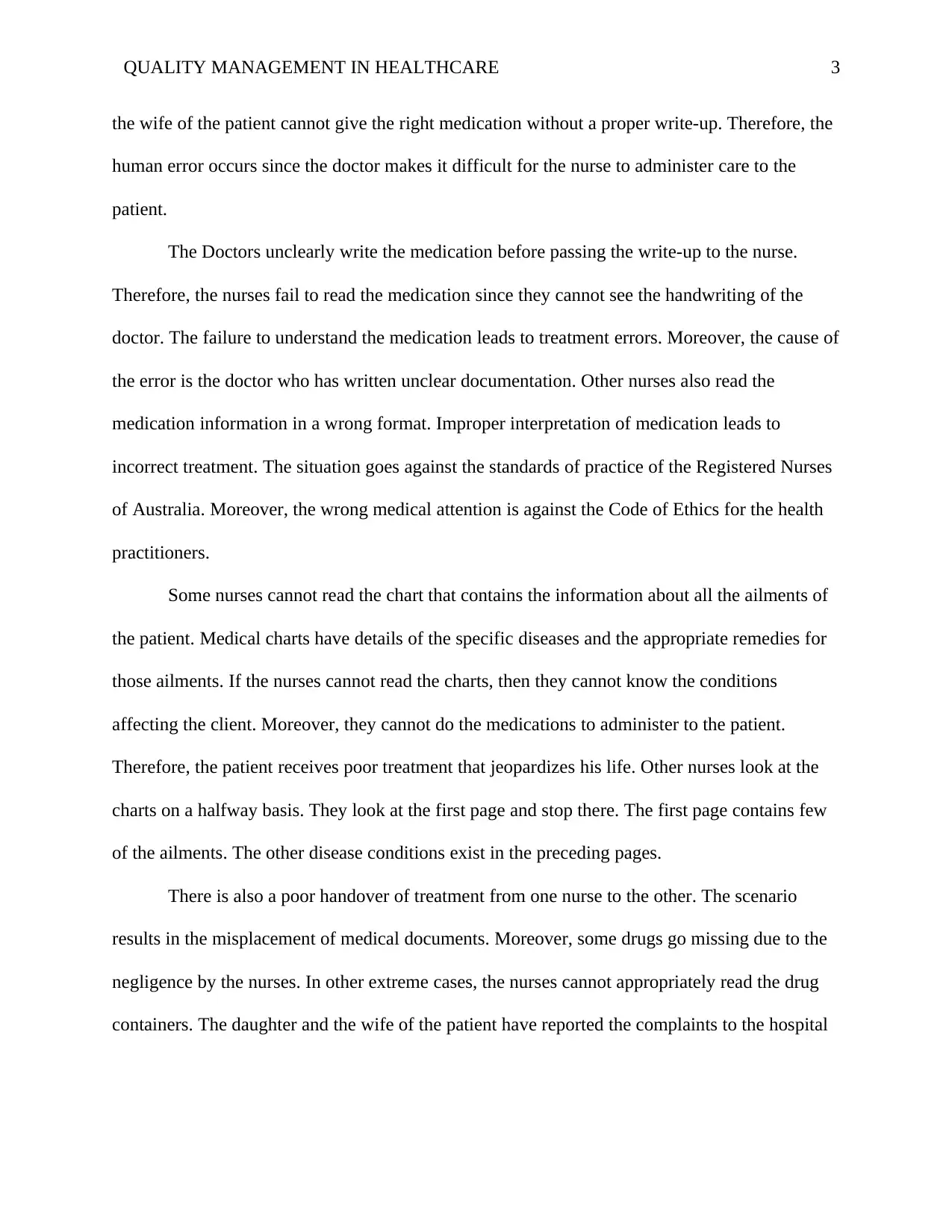
QUALITY MANAGEMENT IN HEALTHCARE 3
the wife of the patient cannot give the right medication without a proper write-up. Therefore, the
human error occurs since the doctor makes it difficult for the nurse to administer care to the
patient.
The Doctors unclearly write the medication before passing the write-up to the nurse.
Therefore, the nurses fail to read the medication since they cannot see the handwriting of the
doctor. The failure to understand the medication leads to treatment errors. Moreover, the cause of
the error is the doctor who has written unclear documentation. Other nurses also read the
medication information in a wrong format. Improper interpretation of medication leads to
incorrect treatment. The situation goes against the standards of practice of the Registered Nurses
of Australia. Moreover, the wrong medical attention is against the Code of Ethics for the health
practitioners.
Some nurses cannot read the chart that contains the information about all the ailments of
the patient. Medical charts have details of the specific diseases and the appropriate remedies for
those ailments. If the nurses cannot read the charts, then they cannot know the conditions
affecting the client. Moreover, they cannot do the medications to administer to the patient.
Therefore, the patient receives poor treatment that jeopardizes his life. Other nurses look at the
charts on a halfway basis. They look at the first page and stop there. The first page contains few
of the ailments. The other disease conditions exist in the preceding pages.
There is also a poor handover of treatment from one nurse to the other. The scenario
results in the misplacement of medical documents. Moreover, some drugs go missing due to the
negligence by the nurses. In other extreme cases, the nurses cannot appropriately read the drug
containers. The daughter and the wife of the patient have reported the complaints to the hospital
the wife of the patient cannot give the right medication without a proper write-up. Therefore, the
human error occurs since the doctor makes it difficult for the nurse to administer care to the
patient.
The Doctors unclearly write the medication before passing the write-up to the nurse.
Therefore, the nurses fail to read the medication since they cannot see the handwriting of the
doctor. The failure to understand the medication leads to treatment errors. Moreover, the cause of
the error is the doctor who has written unclear documentation. Other nurses also read the
medication information in a wrong format. Improper interpretation of medication leads to
incorrect treatment. The situation goes against the standards of practice of the Registered Nurses
of Australia. Moreover, the wrong medical attention is against the Code of Ethics for the health
practitioners.
Some nurses cannot read the chart that contains the information about all the ailments of
the patient. Medical charts have details of the specific diseases and the appropriate remedies for
those ailments. If the nurses cannot read the charts, then they cannot know the conditions
affecting the client. Moreover, they cannot do the medications to administer to the patient.
Therefore, the patient receives poor treatment that jeopardizes his life. Other nurses look at the
charts on a halfway basis. They look at the first page and stop there. The first page contains few
of the ailments. The other disease conditions exist in the preceding pages.
There is also a poor handover of treatment from one nurse to the other. The scenario
results in the misplacement of medical documents. Moreover, some drugs go missing due to the
negligence by the nurses. In other extreme cases, the nurses cannot appropriately read the drug
containers. The daughter and the wife of the patient have reported the complaints to the hospital
⊘ This is a preview!⊘
Do you want full access?
Subscribe today to unlock all pages.

Trusted by 1+ million students worldwide
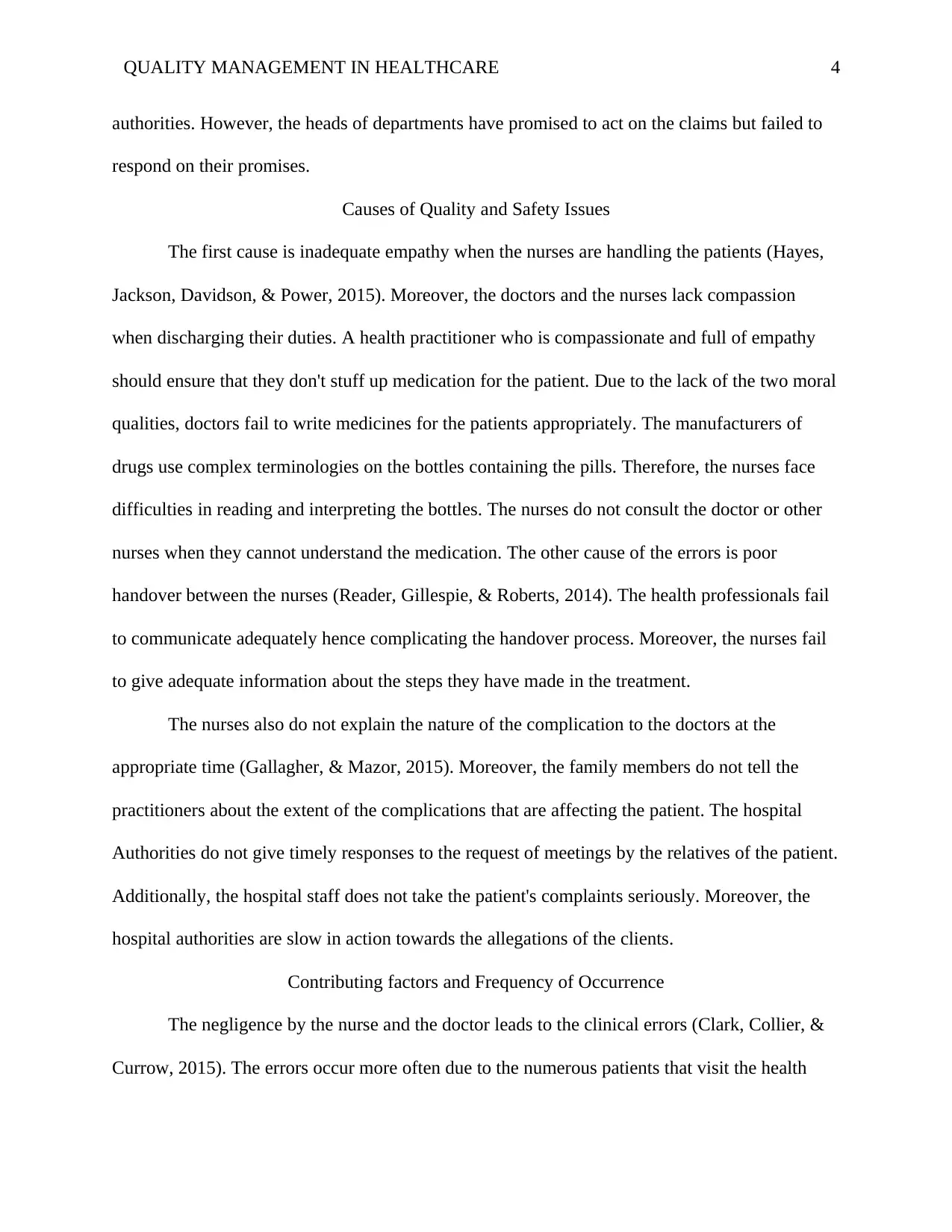
QUALITY MANAGEMENT IN HEALTHCARE 4
authorities. However, the heads of departments have promised to act on the claims but failed to
respond on their promises.
Causes of Quality and Safety Issues
The first cause is inadequate empathy when the nurses are handling the patients (Hayes,
Jackson, Davidson, & Power, 2015). Moreover, the doctors and the nurses lack compassion
when discharging their duties. A health practitioner who is compassionate and full of empathy
should ensure that they don't stuff up medication for the patient. Due to the lack of the two moral
qualities, doctors fail to write medicines for the patients appropriately. The manufacturers of
drugs use complex terminologies on the bottles containing the pills. Therefore, the nurses face
difficulties in reading and interpreting the bottles. The nurses do not consult the doctor or other
nurses when they cannot understand the medication. The other cause of the errors is poor
handover between the nurses (Reader, Gillespie, & Roberts, 2014). The health professionals fail
to communicate adequately hence complicating the handover process. Moreover, the nurses fail
to give adequate information about the steps they have made in the treatment.
The nurses also do not explain the nature of the complication to the doctors at the
appropriate time (Gallagher, & Mazor, 2015). Moreover, the family members do not tell the
practitioners about the extent of the complications that are affecting the patient. The hospital
Authorities do not give timely responses to the request of meetings by the relatives of the patient.
Additionally, the hospital staff does not take the patient's complaints seriously. Moreover, the
hospital authorities are slow in action towards the allegations of the clients.
Contributing factors and Frequency of Occurrence
The negligence by the nurse and the doctor leads to the clinical errors (Clark, Collier, &
Currow, 2015). The errors occur more often due to the numerous patients that visit the health
authorities. However, the heads of departments have promised to act on the claims but failed to
respond on their promises.
Causes of Quality and Safety Issues
The first cause is inadequate empathy when the nurses are handling the patients (Hayes,
Jackson, Davidson, & Power, 2015). Moreover, the doctors and the nurses lack compassion
when discharging their duties. A health practitioner who is compassionate and full of empathy
should ensure that they don't stuff up medication for the patient. Due to the lack of the two moral
qualities, doctors fail to write medicines for the patients appropriately. The manufacturers of
drugs use complex terminologies on the bottles containing the pills. Therefore, the nurses face
difficulties in reading and interpreting the bottles. The nurses do not consult the doctor or other
nurses when they cannot understand the medication. The other cause of the errors is poor
handover between the nurses (Reader, Gillespie, & Roberts, 2014). The health professionals fail
to communicate adequately hence complicating the handover process. Moreover, the nurses fail
to give adequate information about the steps they have made in the treatment.
The nurses also do not explain the nature of the complication to the doctors at the
appropriate time (Gallagher, & Mazor, 2015). Moreover, the family members do not tell the
practitioners about the extent of the complications that are affecting the patient. The hospital
Authorities do not give timely responses to the request of meetings by the relatives of the patient.
Additionally, the hospital staff does not take the patient's complaints seriously. Moreover, the
hospital authorities are slow in action towards the allegations of the clients.
Contributing factors and Frequency of Occurrence
The negligence by the nurse and the doctor leads to the clinical errors (Clark, Collier, &
Currow, 2015). The errors occur more often due to the numerous patients that visit the health
Paraphrase This Document
Need a fresh take? Get an instant paraphrase of this document with our AI Paraphraser

QUALITY MANAGEMENT IN HEALTHCARE 5
facilities. Moreover, the hospital faces understaffing problems. The nurses change medication
without informing the wife of the patient about the changes. Furthermore, the nurses fail to
explain the reasons for the alteration in the type of medical attention. There is lack of training
for the nurses (Young, Menon, Street, Al-Hertani, & Stafinski, 2017).
Prevention Actions
The members of staff should be trained to avoid the errors. The training of nurses should
emphasize the need to properly hand over the treatment files after the completion of their
respective shifts (Brown, Edwards, Seaton, & Buckley, 2017). The doctors need the training to
enable them to improve on their handwriting when writing medication. The training should be in
line with the standards of practice, and the codes of ethics of the Australian Registered Nurses
(Admi, & Eilon-Moshe, 2016). All stakeholders should hold discussions to look at the
complaints made by the patients. Moreover, each stakeholder should give their contributions on
the best ways to eliminate clinical errors. The doctors should share the guidelines on best
practice procedures with the nurses. The methods enable the nurses to minimize errors during the
administration of treatment.
The training should emphasize on the need of proper channels of communication between
the caregivers and the family members of the patient. Nurses should also observe the standards
of practice and ethics when interacting with the relatives of the patient (Scanlon, Cashin, Bryce,
Kelly, & Buckely, 2016). The nurses should improve their handover techniques to prevent the
human errors during treatment. Moreover, the health facility should educate the nurses on the
considerations during the treatment process. The health practitioners should forward the patient’s
complaints to the doctors and eventually to the hospital authorities. The new members of staff
require an adequate sensitization on the procedures of the health facility. They should know
facilities. Moreover, the hospital faces understaffing problems. The nurses change medication
without informing the wife of the patient about the changes. Furthermore, the nurses fail to
explain the reasons for the alteration in the type of medical attention. There is lack of training
for the nurses (Young, Menon, Street, Al-Hertani, & Stafinski, 2017).
Prevention Actions
The members of staff should be trained to avoid the errors. The training of nurses should
emphasize the need to properly hand over the treatment files after the completion of their
respective shifts (Brown, Edwards, Seaton, & Buckley, 2017). The doctors need the training to
enable them to improve on their handwriting when writing medication. The training should be in
line with the standards of practice, and the codes of ethics of the Australian Registered Nurses
(Admi, & Eilon-Moshe, 2016). All stakeholders should hold discussions to look at the
complaints made by the patients. Moreover, each stakeholder should give their contributions on
the best ways to eliminate clinical errors. The doctors should share the guidelines on best
practice procedures with the nurses. The methods enable the nurses to minimize errors during the
administration of treatment.
The training should emphasize on the need of proper channels of communication between
the caregivers and the family members of the patient. Nurses should also observe the standards
of practice and ethics when interacting with the relatives of the patient (Scanlon, Cashin, Bryce,
Kelly, & Buckely, 2016). The nurses should improve their handover techniques to prevent the
human errors during treatment. Moreover, the health facility should educate the nurses on the
considerations during the treatment process. The health practitioners should forward the patient’s
complaints to the doctors and eventually to the hospital authorities. The new members of staff
require an adequate sensitization on the procedures of the health facility. They should know
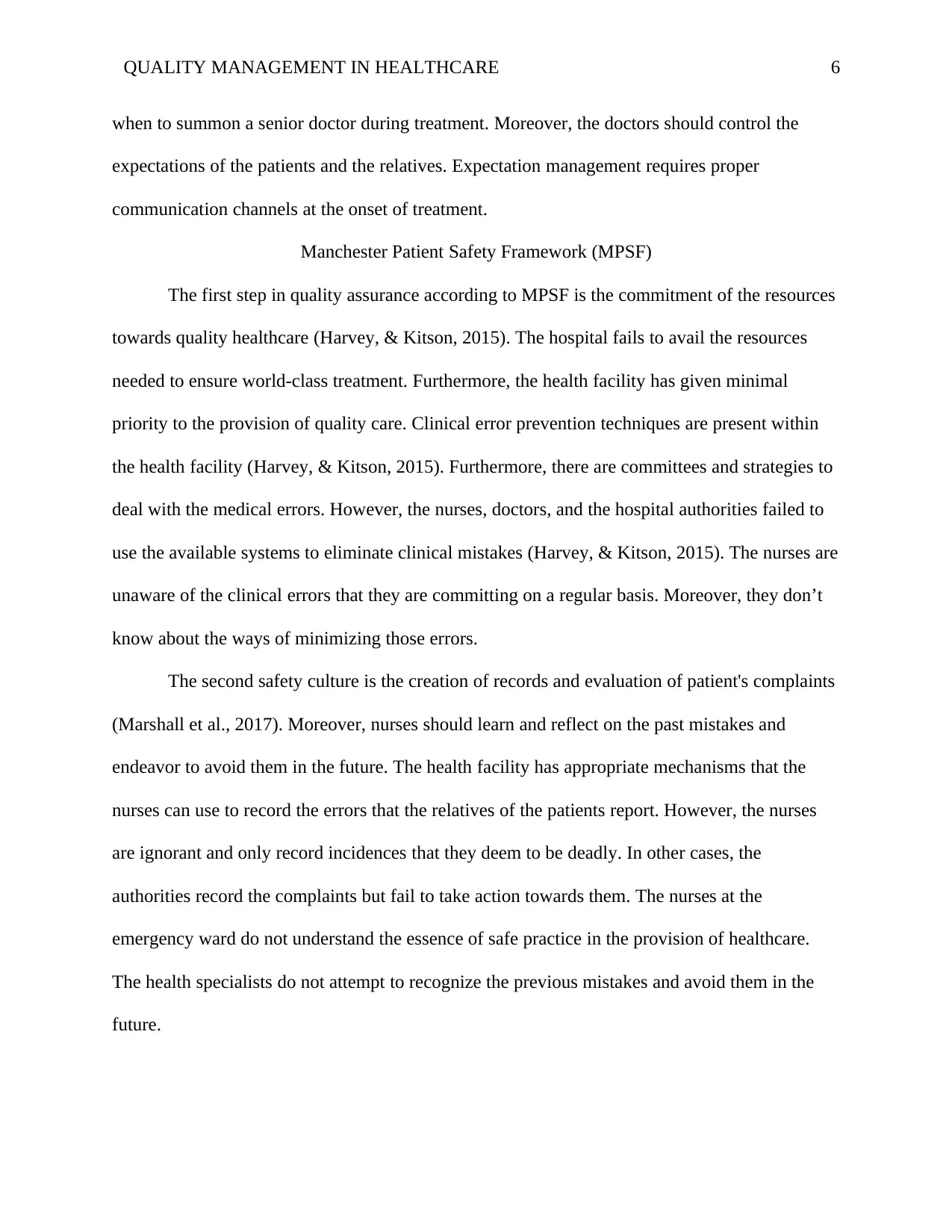
QUALITY MANAGEMENT IN HEALTHCARE 6
when to summon a senior doctor during treatment. Moreover, the doctors should control the
expectations of the patients and the relatives. Expectation management requires proper
communication channels at the onset of treatment.
Manchester Patient Safety Framework (MPSF)
The first step in quality assurance according to MPSF is the commitment of the resources
towards quality healthcare (Harvey, & Kitson, 2015). The hospital fails to avail the resources
needed to ensure world-class treatment. Furthermore, the health facility has given minimal
priority to the provision of quality care. Clinical error prevention techniques are present within
the health facility (Harvey, & Kitson, 2015). Furthermore, there are committees and strategies to
deal with the medical errors. However, the nurses, doctors, and the hospital authorities failed to
use the available systems to eliminate clinical mistakes (Harvey, & Kitson, 2015). The nurses are
unaware of the clinical errors that they are committing on a regular basis. Moreover, they don’t
know about the ways of minimizing those errors.
The second safety culture is the creation of records and evaluation of patient's complaints
(Marshall et al., 2017). Moreover, nurses should learn and reflect on the past mistakes and
endeavor to avoid them in the future. The health facility has appropriate mechanisms that the
nurses can use to record the errors that the relatives of the patients report. However, the nurses
are ignorant and only record incidences that they deem to be deadly. In other cases, the
authorities record the complaints but fail to take action towards them. The nurses at the
emergency ward do not understand the essence of safe practice in the provision of healthcare.
The health specialists do not attempt to recognize the previous mistakes and avoid them in the
future.
when to summon a senior doctor during treatment. Moreover, the doctors should control the
expectations of the patients and the relatives. Expectation management requires proper
communication channels at the onset of treatment.
Manchester Patient Safety Framework (MPSF)
The first step in quality assurance according to MPSF is the commitment of the resources
towards quality healthcare (Harvey, & Kitson, 2015). The hospital fails to avail the resources
needed to ensure world-class treatment. Furthermore, the health facility has given minimal
priority to the provision of quality care. Clinical error prevention techniques are present within
the health facility (Harvey, & Kitson, 2015). Furthermore, there are committees and strategies to
deal with the medical errors. However, the nurses, doctors, and the hospital authorities failed to
use the available systems to eliminate clinical mistakes (Harvey, & Kitson, 2015). The nurses are
unaware of the clinical errors that they are committing on a regular basis. Moreover, they don’t
know about the ways of minimizing those errors.
The second safety culture is the creation of records and evaluation of patient's complaints
(Marshall et al., 2017). Moreover, nurses should learn and reflect on the past mistakes and
endeavor to avoid them in the future. The health facility has appropriate mechanisms that the
nurses can use to record the errors that the relatives of the patients report. However, the nurses
are ignorant and only record incidences that they deem to be deadly. In other cases, the
authorities record the complaints but fail to take action towards them. The nurses at the
emergency ward do not understand the essence of safe practice in the provision of healthcare.
The health specialists do not attempt to recognize the previous mistakes and avoid them in the
future.
⊘ This is a preview!⊘
Do you want full access?
Subscribe today to unlock all pages.

Trusted by 1+ million students worldwide
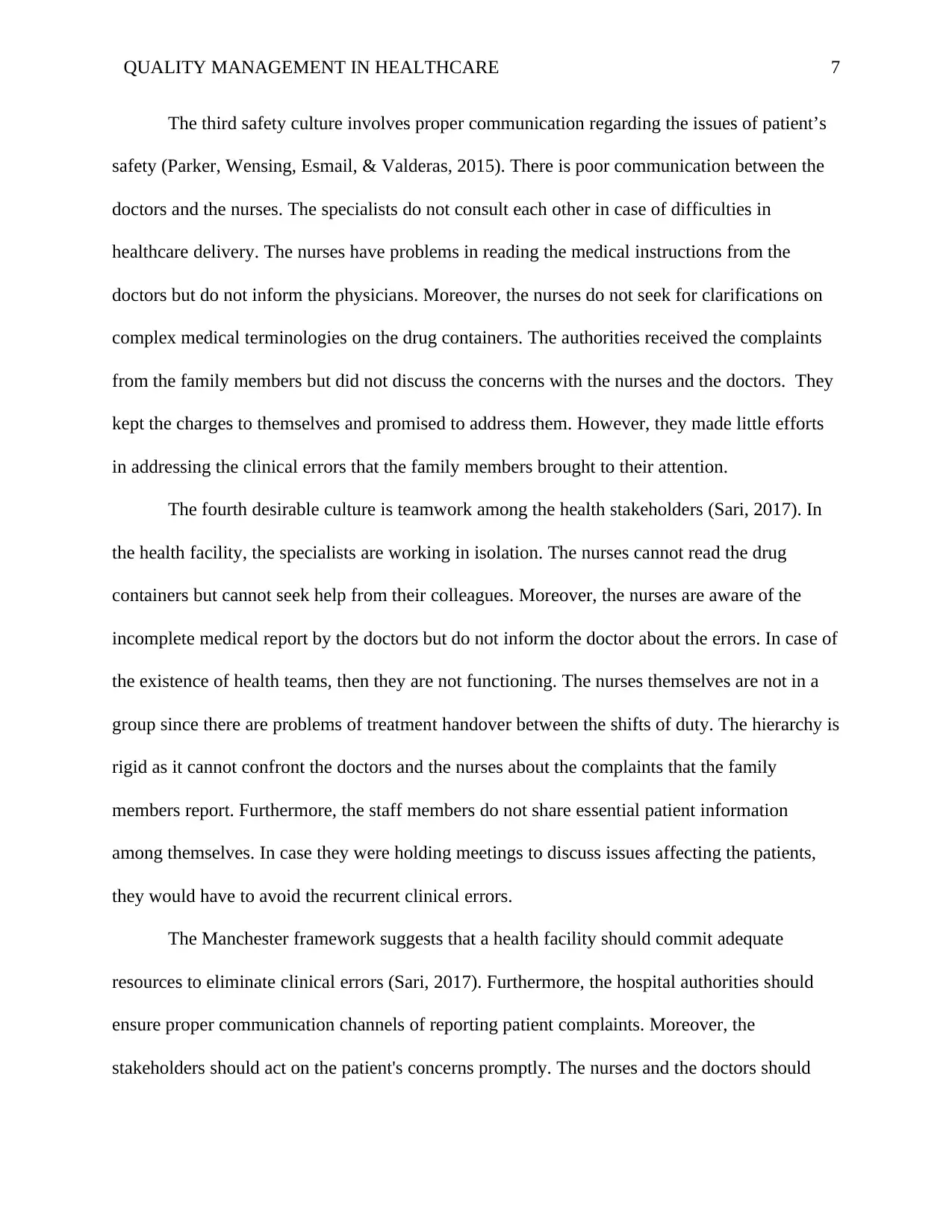
QUALITY MANAGEMENT IN HEALTHCARE 7
The third safety culture involves proper communication regarding the issues of patient’s
safety (Parker, Wensing, Esmail, & Valderas, 2015). There is poor communication between the
doctors and the nurses. The specialists do not consult each other in case of difficulties in
healthcare delivery. The nurses have problems in reading the medical instructions from the
doctors but do not inform the physicians. Moreover, the nurses do not seek for clarifications on
complex medical terminologies on the drug containers. The authorities received the complaints
from the family members but did not discuss the concerns with the nurses and the doctors. They
kept the charges to themselves and promised to address them. However, they made little efforts
in addressing the clinical errors that the family members brought to their attention.
The fourth desirable culture is teamwork among the health stakeholders (Sari, 2017). In
the health facility, the specialists are working in isolation. The nurses cannot read the drug
containers but cannot seek help from their colleagues. Moreover, the nurses are aware of the
incomplete medical report by the doctors but do not inform the doctor about the errors. In case of
the existence of health teams, then they are not functioning. The nurses themselves are not in a
group since there are problems of treatment handover between the shifts of duty. The hierarchy is
rigid as it cannot confront the doctors and the nurses about the complaints that the family
members report. Furthermore, the staff members do not share essential patient information
among themselves. In case they were holding meetings to discuss issues affecting the patients,
they would have to avoid the recurrent clinical errors.
The Manchester framework suggests that a health facility should commit adequate
resources to eliminate clinical errors (Sari, 2017). Furthermore, the hospital authorities should
ensure proper communication channels of reporting patient complaints. Moreover, the
stakeholders should act on the patient's concerns promptly. The nurses and the doctors should
The third safety culture involves proper communication regarding the issues of patient’s
safety (Parker, Wensing, Esmail, & Valderas, 2015). There is poor communication between the
doctors and the nurses. The specialists do not consult each other in case of difficulties in
healthcare delivery. The nurses have problems in reading the medical instructions from the
doctors but do not inform the physicians. Moreover, the nurses do not seek for clarifications on
complex medical terminologies on the drug containers. The authorities received the complaints
from the family members but did not discuss the concerns with the nurses and the doctors. They
kept the charges to themselves and promised to address them. However, they made little efforts
in addressing the clinical errors that the family members brought to their attention.
The fourth desirable culture is teamwork among the health stakeholders (Sari, 2017). In
the health facility, the specialists are working in isolation. The nurses cannot read the drug
containers but cannot seek help from their colleagues. Moreover, the nurses are aware of the
incomplete medical report by the doctors but do not inform the doctor about the errors. In case of
the existence of health teams, then they are not functioning. The nurses themselves are not in a
group since there are problems of treatment handover between the shifts of duty. The hierarchy is
rigid as it cannot confront the doctors and the nurses about the complaints that the family
members report. Furthermore, the staff members do not share essential patient information
among themselves. In case they were holding meetings to discuss issues affecting the patients,
they would have to avoid the recurrent clinical errors.
The Manchester framework suggests that a health facility should commit adequate
resources to eliminate clinical errors (Sari, 2017). Furthermore, the hospital authorities should
ensure proper communication channels of reporting patient complaints. Moreover, the
stakeholders should act on the patient's concerns promptly. The nurses and the doctors should
Paraphrase This Document
Need a fresh take? Get an instant paraphrase of this document with our AI Paraphraser
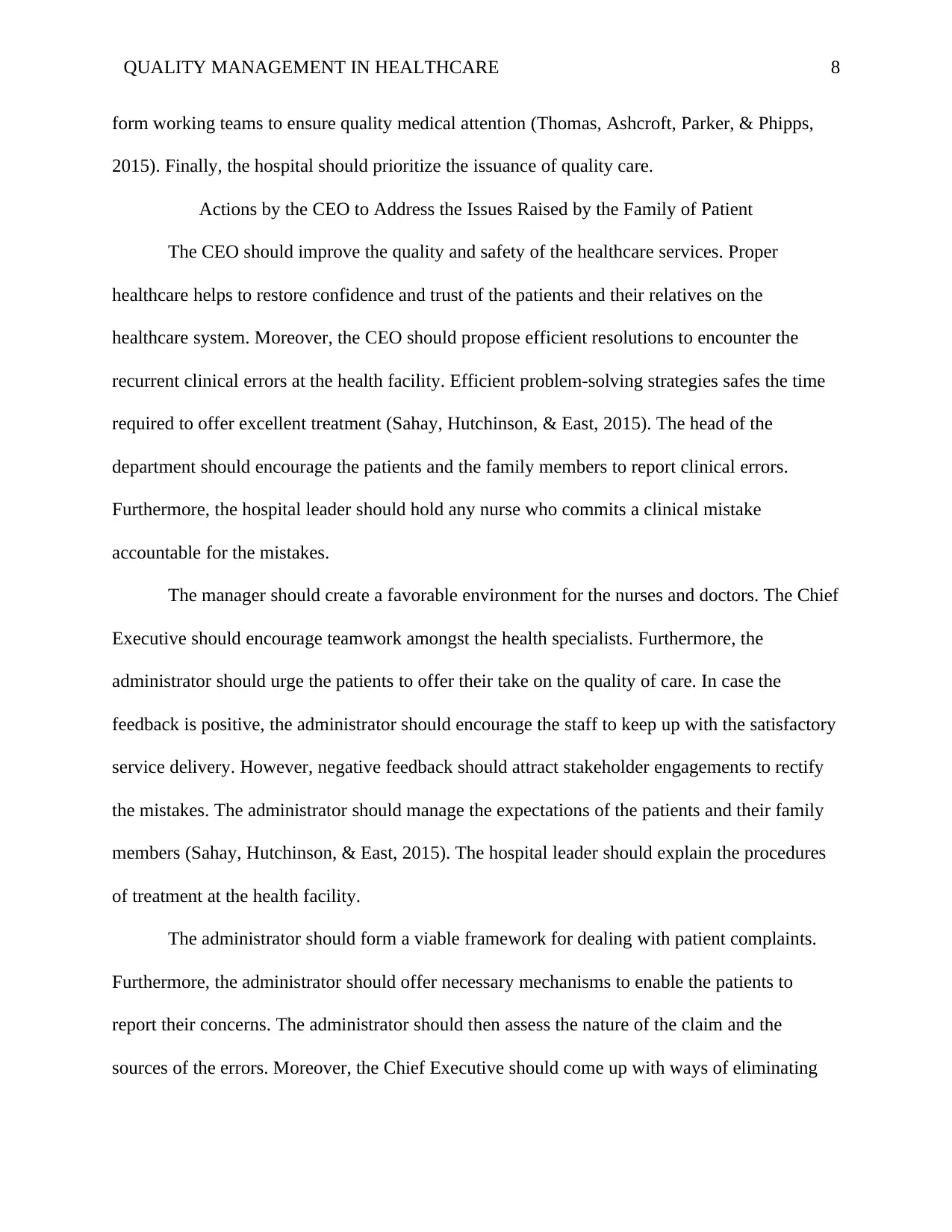
QUALITY MANAGEMENT IN HEALTHCARE 8
form working teams to ensure quality medical attention (Thomas, Ashcroft, Parker, & Phipps,
2015). Finally, the hospital should prioritize the issuance of quality care.
Actions by the CEO to Address the Issues Raised by the Family of Patient
The CEO should improve the quality and safety of the healthcare services. Proper
healthcare helps to restore confidence and trust of the patients and their relatives on the
healthcare system. Moreover, the CEO should propose efficient resolutions to encounter the
recurrent clinical errors at the health facility. Efficient problem-solving strategies safes the time
required to offer excellent treatment (Sahay, Hutchinson, & East, 2015). The head of the
department should encourage the patients and the family members to report clinical errors.
Furthermore, the hospital leader should hold any nurse who commits a clinical mistake
accountable for the mistakes.
The manager should create a favorable environment for the nurses and doctors. The Chief
Executive should encourage teamwork amongst the health specialists. Furthermore, the
administrator should urge the patients to offer their take on the quality of care. In case the
feedback is positive, the administrator should encourage the staff to keep up with the satisfactory
service delivery. However, negative feedback should attract stakeholder engagements to rectify
the mistakes. The administrator should manage the expectations of the patients and their family
members (Sahay, Hutchinson, & East, 2015). The hospital leader should explain the procedures
of treatment at the health facility.
The administrator should form a viable framework for dealing with patient complaints.
Furthermore, the administrator should offer necessary mechanisms to enable the patients to
report their concerns. The administrator should then assess the nature of the claim and the
sources of the errors. Moreover, the Chief Executive should come up with ways of eliminating
form working teams to ensure quality medical attention (Thomas, Ashcroft, Parker, & Phipps,
2015). Finally, the hospital should prioritize the issuance of quality care.
Actions by the CEO to Address the Issues Raised by the Family of Patient
The CEO should improve the quality and safety of the healthcare services. Proper
healthcare helps to restore confidence and trust of the patients and their relatives on the
healthcare system. Moreover, the CEO should propose efficient resolutions to encounter the
recurrent clinical errors at the health facility. Efficient problem-solving strategies safes the time
required to offer excellent treatment (Sahay, Hutchinson, & East, 2015). The head of the
department should encourage the patients and the family members to report clinical errors.
Furthermore, the hospital leader should hold any nurse who commits a clinical mistake
accountable for the mistakes.
The manager should create a favorable environment for the nurses and doctors. The Chief
Executive should encourage teamwork amongst the health specialists. Furthermore, the
administrator should urge the patients to offer their take on the quality of care. In case the
feedback is positive, the administrator should encourage the staff to keep up with the satisfactory
service delivery. However, negative feedback should attract stakeholder engagements to rectify
the mistakes. The administrator should manage the expectations of the patients and their family
members (Sahay, Hutchinson, & East, 2015). The hospital leader should explain the procedures
of treatment at the health facility.
The administrator should form a viable framework for dealing with patient complaints.
Furthermore, the administrator should offer necessary mechanisms to enable the patients to
report their concerns. The administrator should then assess the nature of the claim and the
sources of the errors. Moreover, the Chief Executive should come up with ways of eliminating
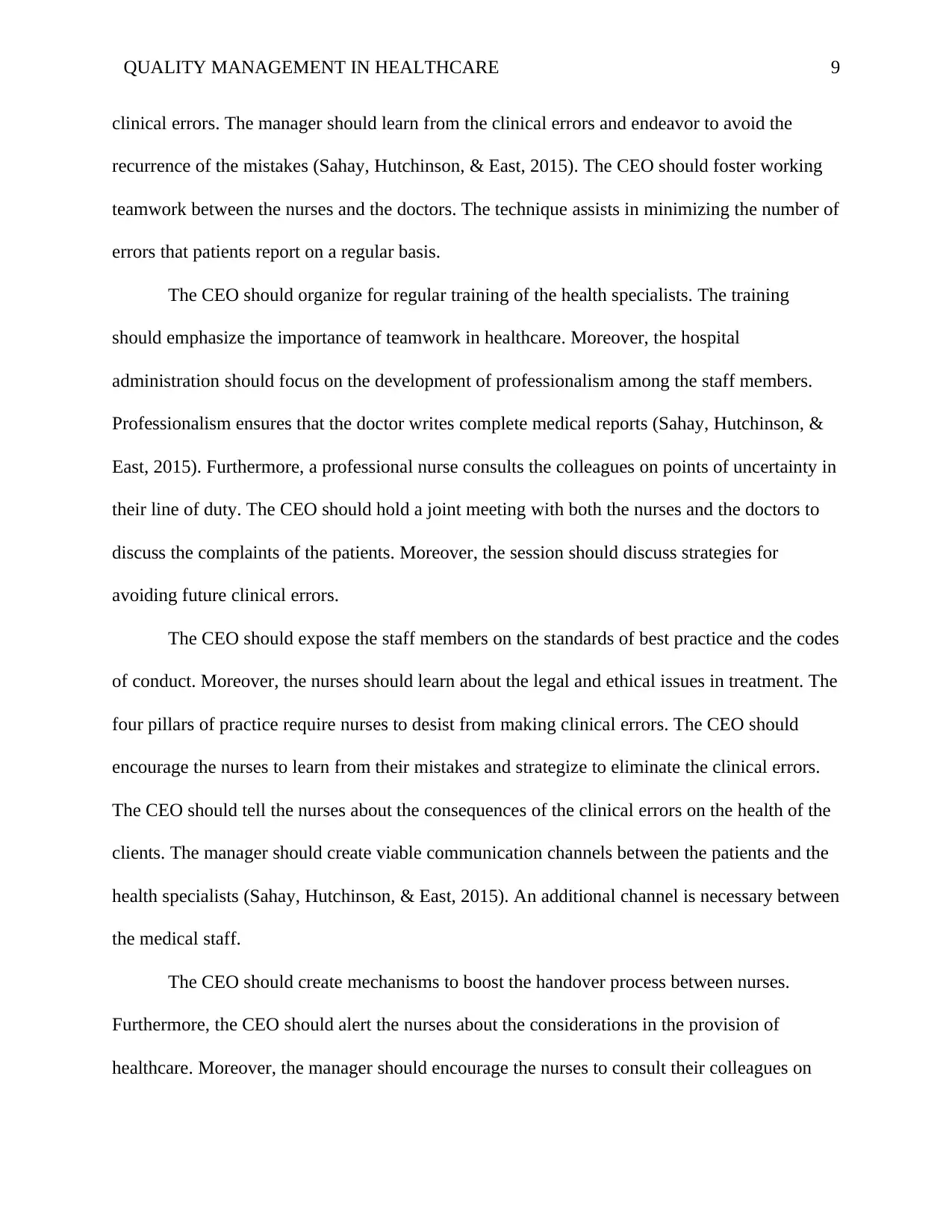
QUALITY MANAGEMENT IN HEALTHCARE 9
clinical errors. The manager should learn from the clinical errors and endeavor to avoid the
recurrence of the mistakes (Sahay, Hutchinson, & East, 2015). The CEO should foster working
teamwork between the nurses and the doctors. The technique assists in minimizing the number of
errors that patients report on a regular basis.
The CEO should organize for regular training of the health specialists. The training
should emphasize the importance of teamwork in healthcare. Moreover, the hospital
administration should focus on the development of professionalism among the staff members.
Professionalism ensures that the doctor writes complete medical reports (Sahay, Hutchinson, &
East, 2015). Furthermore, a professional nurse consults the colleagues on points of uncertainty in
their line of duty. The CEO should hold a joint meeting with both the nurses and the doctors to
discuss the complaints of the patients. Moreover, the session should discuss strategies for
avoiding future clinical errors.
The CEO should expose the staff members on the standards of best practice and the codes
of conduct. Moreover, the nurses should learn about the legal and ethical issues in treatment. The
four pillars of practice require nurses to desist from making clinical errors. The CEO should
encourage the nurses to learn from their mistakes and strategize to eliminate the clinical errors.
The CEO should tell the nurses about the consequences of the clinical errors on the health of the
clients. The manager should create viable communication channels between the patients and the
health specialists (Sahay, Hutchinson, & East, 2015). An additional channel is necessary between
the medical staff.
The CEO should create mechanisms to boost the handover process between nurses.
Furthermore, the CEO should alert the nurses about the considerations in the provision of
healthcare. Moreover, the manager should encourage the nurses to consult their colleagues on
clinical errors. The manager should learn from the clinical errors and endeavor to avoid the
recurrence of the mistakes (Sahay, Hutchinson, & East, 2015). The CEO should foster working
teamwork between the nurses and the doctors. The technique assists in minimizing the number of
errors that patients report on a regular basis.
The CEO should organize for regular training of the health specialists. The training
should emphasize the importance of teamwork in healthcare. Moreover, the hospital
administration should focus on the development of professionalism among the staff members.
Professionalism ensures that the doctor writes complete medical reports (Sahay, Hutchinson, &
East, 2015). Furthermore, a professional nurse consults the colleagues on points of uncertainty in
their line of duty. The CEO should hold a joint meeting with both the nurses and the doctors to
discuss the complaints of the patients. Moreover, the session should discuss strategies for
avoiding future clinical errors.
The CEO should expose the staff members on the standards of best practice and the codes
of conduct. Moreover, the nurses should learn about the legal and ethical issues in treatment. The
four pillars of practice require nurses to desist from making clinical errors. The CEO should
encourage the nurses to learn from their mistakes and strategize to eliminate the clinical errors.
The CEO should tell the nurses about the consequences of the clinical errors on the health of the
clients. The manager should create viable communication channels between the patients and the
health specialists (Sahay, Hutchinson, & East, 2015). An additional channel is necessary between
the medical staff.
The CEO should create mechanisms to boost the handover process between nurses.
Furthermore, the CEO should alert the nurses about the considerations in the provision of
healthcare. Moreover, the manager should encourage the nurses to consult their colleagues on
⊘ This is a preview!⊘
Do you want full access?
Subscribe today to unlock all pages.

Trusted by 1+ million students worldwide
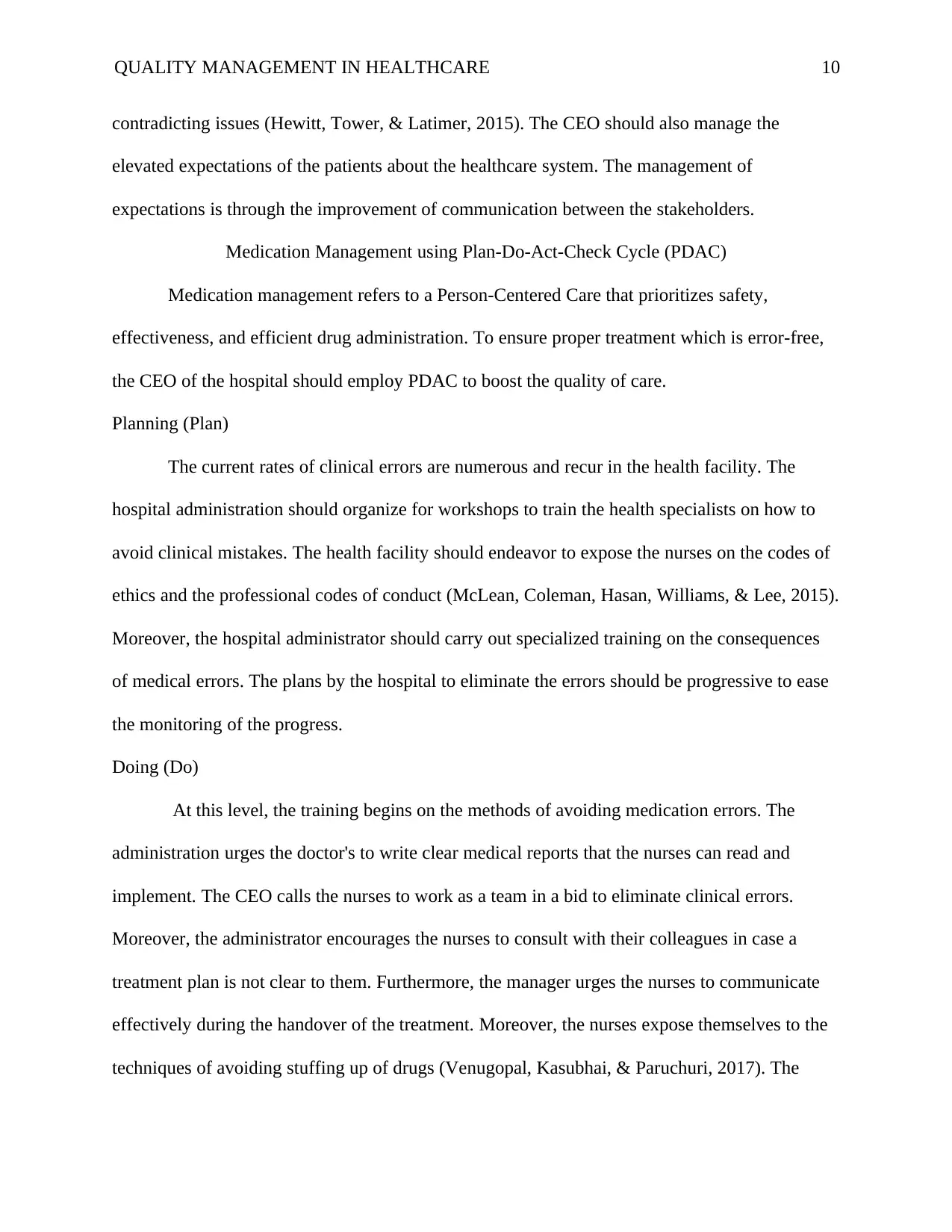
QUALITY MANAGEMENT IN HEALTHCARE 10
contradicting issues (Hewitt, Tower, & Latimer, 2015). The CEO should also manage the
elevated expectations of the patients about the healthcare system. The management of
expectations is through the improvement of communication between the stakeholders.
Medication Management using Plan-Do-Act-Check Cycle (PDAC)
Medication management refers to a Person-Centered Care that prioritizes safety,
effectiveness, and efficient drug administration. To ensure proper treatment which is error-free,
the CEO of the hospital should employ PDAC to boost the quality of care.
Planning (Plan)
The current rates of clinical errors are numerous and recur in the health facility. The
hospital administration should organize for workshops to train the health specialists on how to
avoid clinical mistakes. The health facility should endeavor to expose the nurses on the codes of
ethics and the professional codes of conduct (McLean, Coleman, Hasan, Williams, & Lee, 2015).
Moreover, the hospital administrator should carry out specialized training on the consequences
of medical errors. The plans by the hospital to eliminate the errors should be progressive to ease
the monitoring of the progress.
Doing (Do)
At this level, the training begins on the methods of avoiding medication errors. The
administration urges the doctor's to write clear medical reports that the nurses can read and
implement. The CEO calls the nurses to work as a team in a bid to eliminate clinical errors.
Moreover, the administrator encourages the nurses to consult with their colleagues in case a
treatment plan is not clear to them. Furthermore, the manager urges the nurses to communicate
effectively during the handover of the treatment. Moreover, the nurses expose themselves to the
techniques of avoiding stuffing up of drugs (Venugopal, Kasubhai, & Paruchuri, 2017). The
contradicting issues (Hewitt, Tower, & Latimer, 2015). The CEO should also manage the
elevated expectations of the patients about the healthcare system. The management of
expectations is through the improvement of communication between the stakeholders.
Medication Management using Plan-Do-Act-Check Cycle (PDAC)
Medication management refers to a Person-Centered Care that prioritizes safety,
effectiveness, and efficient drug administration. To ensure proper treatment which is error-free,
the CEO of the hospital should employ PDAC to boost the quality of care.
Planning (Plan)
The current rates of clinical errors are numerous and recur in the health facility. The
hospital administration should organize for workshops to train the health specialists on how to
avoid clinical mistakes. The health facility should endeavor to expose the nurses on the codes of
ethics and the professional codes of conduct (McLean, Coleman, Hasan, Williams, & Lee, 2015).
Moreover, the hospital administrator should carry out specialized training on the consequences
of medical errors. The plans by the hospital to eliminate the errors should be progressive to ease
the monitoring of the progress.
Doing (Do)
At this level, the training begins on the methods of avoiding medication errors. The
administration urges the doctor's to write clear medical reports that the nurses can read and
implement. The CEO calls the nurses to work as a team in a bid to eliminate clinical errors.
Moreover, the administrator encourages the nurses to consult with their colleagues in case a
treatment plan is not clear to them. Furthermore, the manager urges the nurses to communicate
effectively during the handover of the treatment. Moreover, the nurses expose themselves to the
techniques of avoiding stuffing up of drugs (Venugopal, Kasubhai, & Paruchuri, 2017). The
Paraphrase This Document
Need a fresh take? Get an instant paraphrase of this document with our AI Paraphraser
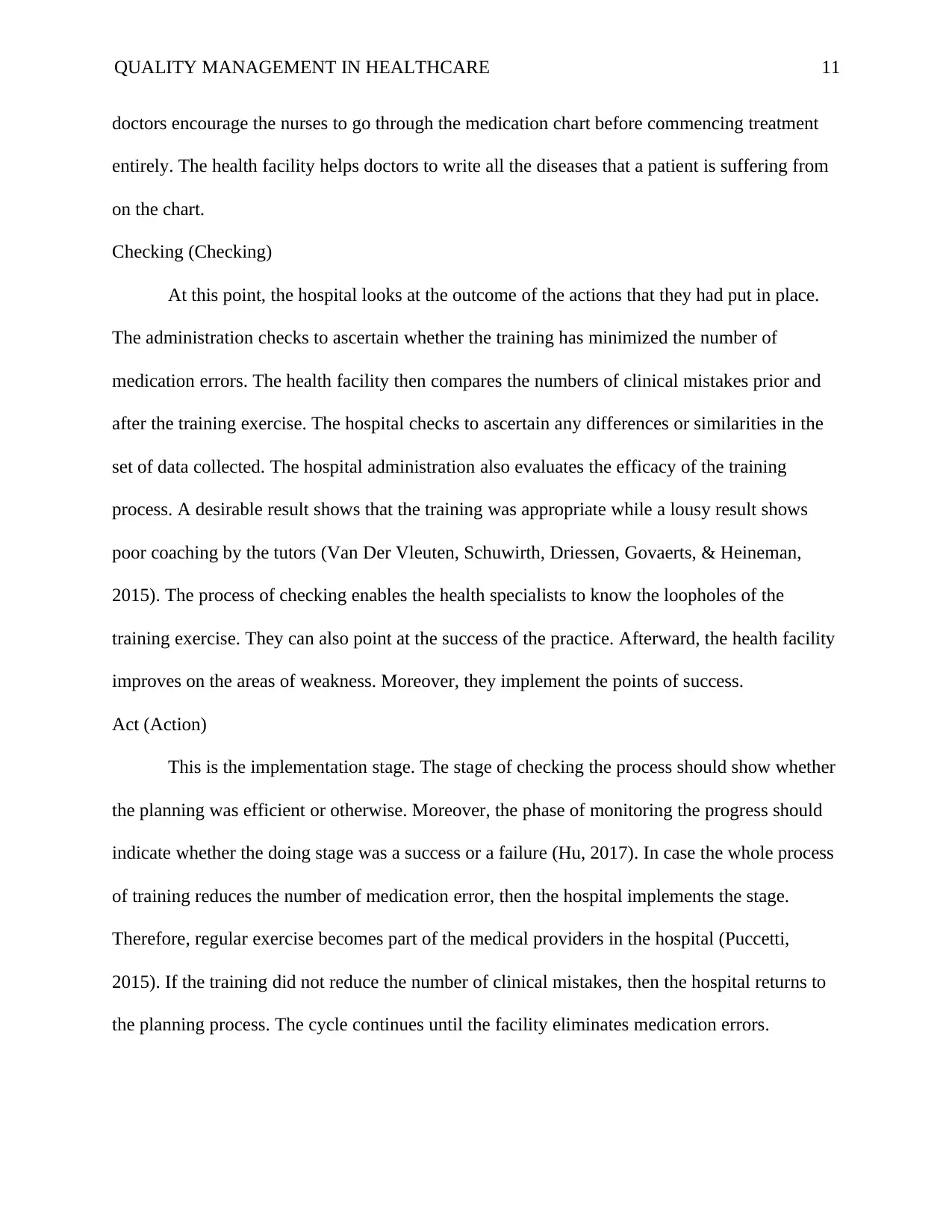
QUALITY MANAGEMENT IN HEALTHCARE 11
doctors encourage the nurses to go through the medication chart before commencing treatment
entirely. The health facility helps doctors to write all the diseases that a patient is suffering from
on the chart.
Checking (Checking)
At this point, the hospital looks at the outcome of the actions that they had put in place.
The administration checks to ascertain whether the training has minimized the number of
medication errors. The health facility then compares the numbers of clinical mistakes prior and
after the training exercise. The hospital checks to ascertain any differences or similarities in the
set of data collected. The hospital administration also evaluates the efficacy of the training
process. A desirable result shows that the training was appropriate while a lousy result shows
poor coaching by the tutors (Van Der Vleuten, Schuwirth, Driessen, Govaerts, & Heineman,
2015). The process of checking enables the health specialists to know the loopholes of the
training exercise. They can also point at the success of the practice. Afterward, the health facility
improves on the areas of weakness. Moreover, they implement the points of success.
Act (Action)
This is the implementation stage. The stage of checking the process should show whether
the planning was efficient or otherwise. Moreover, the phase of monitoring the progress should
indicate whether the doing stage was a success or a failure (Hu, 2017). In case the whole process
of training reduces the number of medication error, then the hospital implements the stage.
Therefore, regular exercise becomes part of the medical providers in the hospital (Puccetti,
2015). If the training did not reduce the number of clinical mistakes, then the hospital returns to
the planning process. The cycle continues until the facility eliminates medication errors.
doctors encourage the nurses to go through the medication chart before commencing treatment
entirely. The health facility helps doctors to write all the diseases that a patient is suffering from
on the chart.
Checking (Checking)
At this point, the hospital looks at the outcome of the actions that they had put in place.
The administration checks to ascertain whether the training has minimized the number of
medication errors. The health facility then compares the numbers of clinical mistakes prior and
after the training exercise. The hospital checks to ascertain any differences or similarities in the
set of data collected. The hospital administration also evaluates the efficacy of the training
process. A desirable result shows that the training was appropriate while a lousy result shows
poor coaching by the tutors (Van Der Vleuten, Schuwirth, Driessen, Govaerts, & Heineman,
2015). The process of checking enables the health specialists to know the loopholes of the
training exercise. They can also point at the success of the practice. Afterward, the health facility
improves on the areas of weakness. Moreover, they implement the points of success.
Act (Action)
This is the implementation stage. The stage of checking the process should show whether
the planning was efficient or otherwise. Moreover, the phase of monitoring the progress should
indicate whether the doing stage was a success or a failure (Hu, 2017). In case the whole process
of training reduces the number of medication error, then the hospital implements the stage.
Therefore, regular exercise becomes part of the medical providers in the hospital (Puccetti,
2015). If the training did not reduce the number of clinical mistakes, then the hospital returns to
the planning process. The cycle continues until the facility eliminates medication errors.
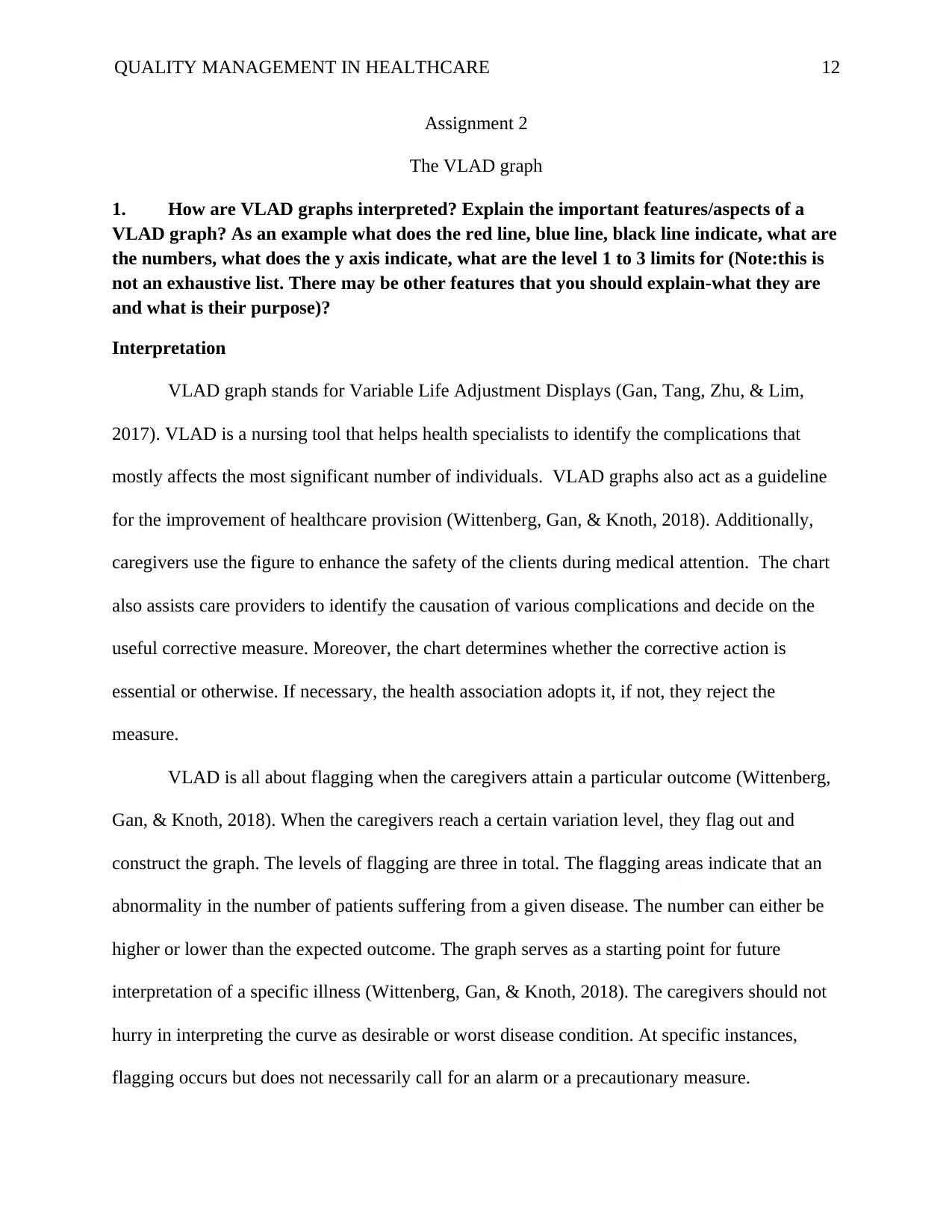
QUALITY MANAGEMENT IN HEALTHCARE 12
Assignment 2
The VLAD graph
1. How are VLAD graphs interpreted? Explain the important features/aspects of a
VLAD graph? As an example what does the red line, blue line, black line indicate, what are
the numbers, what does the y axis indicate, what are the level 1 to 3 limits for (Note:this is
not an exhaustive list. There may be other features that you should explain-what they are
and what is their purpose)?
Interpretation
VLAD graph stands for Variable Life Adjustment Displays (Gan, Tang, Zhu, & Lim,
2017). VLAD is a nursing tool that helps health specialists to identify the complications that
mostly affects the most significant number of individuals. VLAD graphs also act as a guideline
for the improvement of healthcare provision (Wittenberg, Gan, & Knoth, 2018). Additionally,
caregivers use the figure to enhance the safety of the clients during medical attention. The chart
also assists care providers to identify the causation of various complications and decide on the
useful corrective measure. Moreover, the chart determines whether the corrective action is
essential or otherwise. If necessary, the health association adopts it, if not, they reject the
measure.
VLAD is all about flagging when the caregivers attain a particular outcome (Wittenberg,
Gan, & Knoth, 2018). When the caregivers reach a certain variation level, they flag out and
construct the graph. The levels of flagging are three in total. The flagging areas indicate that an
abnormality in the number of patients suffering from a given disease. The number can either be
higher or lower than the expected outcome. The graph serves as a starting point for future
interpretation of a specific illness (Wittenberg, Gan, & Knoth, 2018). The caregivers should not
hurry in interpreting the curve as desirable or worst disease condition. At specific instances,
flagging occurs but does not necessarily call for an alarm or a precautionary measure.
Assignment 2
The VLAD graph
1. How are VLAD graphs interpreted? Explain the important features/aspects of a
VLAD graph? As an example what does the red line, blue line, black line indicate, what are
the numbers, what does the y axis indicate, what are the level 1 to 3 limits for (Note:this is
not an exhaustive list. There may be other features that you should explain-what they are
and what is their purpose)?
Interpretation
VLAD graph stands for Variable Life Adjustment Displays (Gan, Tang, Zhu, & Lim,
2017). VLAD is a nursing tool that helps health specialists to identify the complications that
mostly affects the most significant number of individuals. VLAD graphs also act as a guideline
for the improvement of healthcare provision (Wittenberg, Gan, & Knoth, 2018). Additionally,
caregivers use the figure to enhance the safety of the clients during medical attention. The chart
also assists care providers to identify the causation of various complications and decide on the
useful corrective measure. Moreover, the chart determines whether the corrective action is
essential or otherwise. If necessary, the health association adopts it, if not, they reject the
measure.
VLAD is all about flagging when the caregivers attain a particular outcome (Wittenberg,
Gan, & Knoth, 2018). When the caregivers reach a certain variation level, they flag out and
construct the graph. The levels of flagging are three in total. The flagging areas indicate that an
abnormality in the number of patients suffering from a given disease. The number can either be
higher or lower than the expected outcome. The graph serves as a starting point for future
interpretation of a specific illness (Wittenberg, Gan, & Knoth, 2018). The caregivers should not
hurry in interpreting the curve as desirable or worst disease condition. At specific instances,
flagging occurs but does not necessarily call for an alarm or a precautionary measure.
⊘ This is a preview!⊘
Do you want full access?
Subscribe today to unlock all pages.

Trusted by 1+ million students worldwide
1 out of 24
Related Documents
Your All-in-One AI-Powered Toolkit for Academic Success.
+13062052269
info@desklib.com
Available 24*7 on WhatsApp / Email
![[object Object]](/_next/static/media/star-bottom.7253800d.svg)
Unlock your academic potential
Copyright © 2020–2025 A2Z Services. All Rights Reserved. Developed and managed by ZUCOL.





